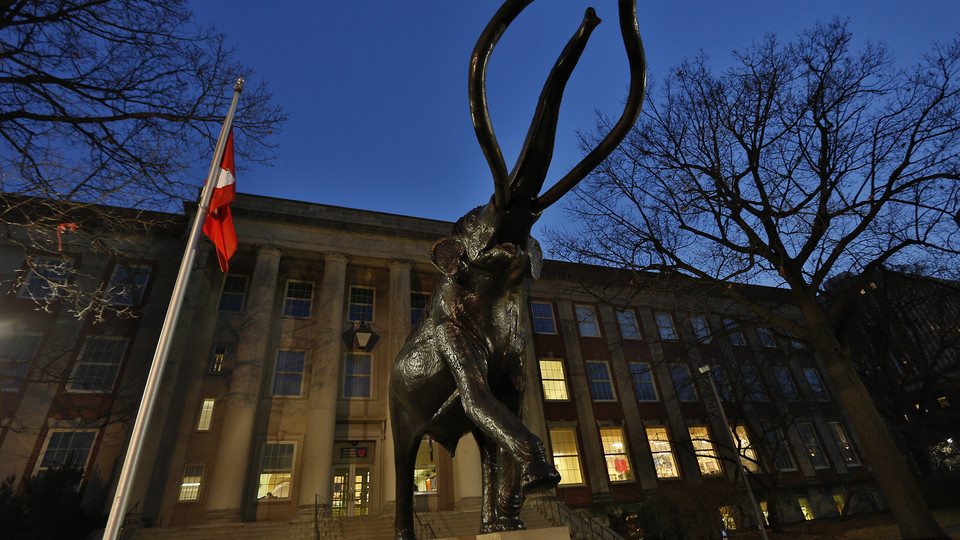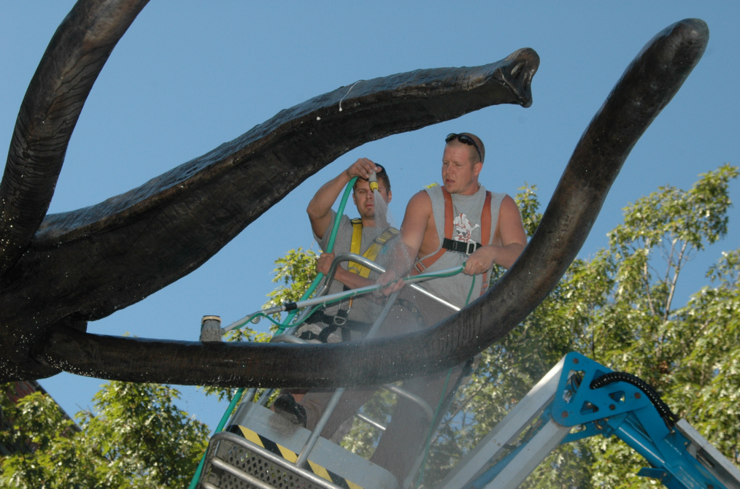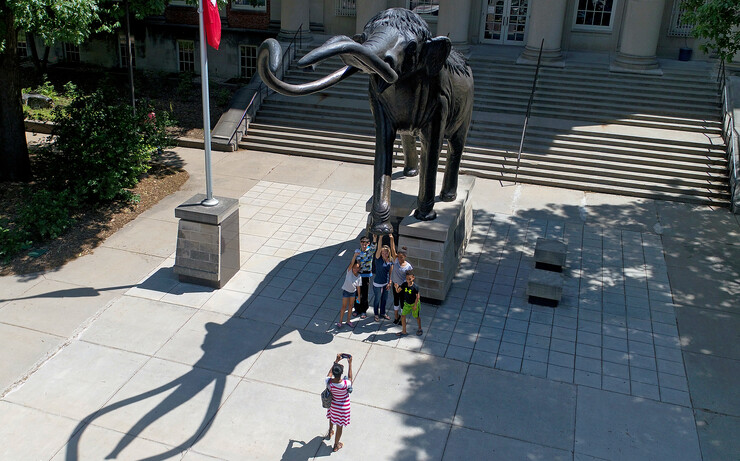· 8 min read
Archie strides into 20th year

Archie the mammoth has been welcoming University of Nebraska State Museum visitors for 20 years.
In honor of Archie’s anniversary — and as work continues toward the February opening of new exhibition space — the museum will be giving away miniature mammoth plushes to students across City Campus on Oct. 24. Here are 20 facts about Archie, Nebraska’s iconic sculpture and record-setting fossil mount.
Based on a record-setter
The sculpture is based on the University of Nebraska State Museum’s Columbian mammoth fossil display — which is also named Archie. Located in the museum’s Elephant Hall, the 14-foot-tall Archie is the tallest mammoth mounted on exhibit in the world. Archie is also the museum’s mascot.
Chicken feed
The Archie mount inside the museum is a composite made from fossils of four individual Columbian mammoths. The majority of the mount features fossilized bones discovered by chickens in 1921 on the Lincoln County ranch of Henry Kariger. The rancher described the find in a letter to Erwin Barbour, then director of the museum. Barbour requested Kariger leave the fossils until spring when a museum crew could assess the find.
Archie arrives in Lincoln
Kariger ignored Barbour’s wishes and excavated the skeleton, hauling the fossils out of the hillside with a team of horses. Luckily, the fossils remained mostly intact and the rancher displayed his find at the 1922 Nebraska State Fair in Lincoln. Barbour ventured to the fair to meet Kariger and assess the fossil find. In a description to Henry Osborn of the American Museum of Natural History, Barbour reported that the skeleton was complete except for tusks and lower limbs.
Bootlegging legend
An account by Walter Linnemeyer (who would have been 6-years-old at the time) claims that Kraiger was selling bootlegged whiskey in his state fair tent and that authorities confiscated both the alcohol and mammoth fossil. While it makes for a good story, George Corner, vertebrate paleontology collections manager for the museum, said the fossil was not confiscated and given to the museum due to a Prohibition violation.
Fair purchase
Museum records show that Barbour added the specimen to the museum collection by paying Kariger $250. In December 1922, Kariger reported to have found a tusk in the same hillside as the rest of the Archie discovery. The find was damaged by Kariger removing it from the ground and pigs chewing on it. Barbour and his team excavated the hill where Archie was discovered in 1923, but unearthed no additional remnants of the skeleton.
Mammoth by any other name
In his initial reports, Barbour declared the Kariger mammoth a new species, Elephas maibeni. The name also honored museum donor Hector Maiben. A 1936 monograph by Osborn redescribed it as Archidiskodon imperator — generating the mammoth mascot’s Archie nickname. Archidiskodon has since been added to the Mammuthus columbi — Columbian mammoth — species, which ranged through the western United States and Central America during the Pleistocene epoch (2.5 million to 11,700 years ago).
Tiny relatives
The pygmy mammoth, or Channel Islands mammoth, is an extinct species of dwarf elephant descended from the Columbian mammoth. The species was on average 5 feet, 6 inches tall and weighted 1,680 pounds. The species is an example of insular dwarfism (a condition caused by large animals evolving a reduced body size when the population is limited to a small environment, most likely on an island). Pygmy mammoth fossils were first discovered in 1856 on the northern Channel Islands of California. A pygmy mammoth fossilized mount stands at the foot of Archie within the NU State Museum’s Elephant Hall.
Museum gatekeeper
While the Archie sculpture welcomes visitors to Morrill Hall today, Archie’s fossil legs once marked the entrance of the museum’s previous building. As space was limited in the museum, Barbour mounted the forelimbs, a few ribs and vertebrate in 1925 to form an archway in the old museum.
Centerpiece display
The Archie fossil mount was completed and on display within NU State Museum (also known as Morrill Hall) in the spring of 1933. The mount is 14-feet tall and 25-feet long. Today, Archie serves as the centerpiece in the museum’s Elephant Hall, a room which showcases the evolution of elephants.
Archie triple play
There are three versions of Archie on display at the museum — four if you happen to visit on a day a volunteer dresses up in the museum’s mascot costume. Joining the bronze and fossilized versions of Archie is a massive Elephant Hall mural that showcases Columbian mammoths — led by Archie — in an ancient scene from the Great Plains. The mural was painted by Mark Marcuson.
State fossil
The mammoth (Elephas primigenius) officially was named the Nebraska state fossil with a bill passed by the legislature on March 1, 1967, as part of the Cornhusker State’s 100th birthday celebration.
Composition
Archie the bronze mammoth was cast at Caleco Foundry in Cody, Wyoming. The sculpture was pieced together from 86 cast sections made from an estimated 3 tons of bronze. The sculpture began as a wooden skeleton covered with foam “muscles” before clay was added to form skin details. Museum exhibits staff and other volunteers helped Hoppe complete the sculpt.
Measuring in
The finalized Archie sculpture weighed in at 2.5 tons. It is 16 feet long from tail to tusk, and 15 feet, 6 inches tall. The living/breathing version of Archie that roamed the plains 30,000 years ago weighed in at 15 tons and was 25 feet, 7 inches long.
Local artist
Archie was created by Malcolm-based artist Fred Hoppe, who was a Nebraska business student in the 1970s. Hoppe is also the sculptor of “Husker Legacy,” a bronze located on the east side of Memorial Stadium.
Celebrated statewide
Before settling into campus on Oct. 21, 1998, Archie was celebrated on his journey across Nebraska. Friends of the State Museum organized an event in North Platte. Archie’s delivery marked the first time in more than 10,000 years that a Columbian mammoth trekked across what is now the Cornhusker State.
Community art
The $275,000 artwork was funded through the sale of 100 miniature Archie sculptures. The community fundraiser was organized by the Friends of the Museum.
Dedicated and honored
The Archie sculpture and Tanner Plaza on which it was placed were officially dedicated during a ceremony on Nov. 21, 1998. The plaza is named in honor of Lloyd G. Tanner, a former field supervisor in fossil collection for the NU State Museum.
Mammoth cleaning
To maintain Archie’s presence for future generations, the museum schedules regular cleanings of the bronze and fossilized mammoths. The sculpture is washed and waxed — top to bottom — annually. While each fossil mount within Elephant Hall is vacuumed to remove dust and assessed for possible damage each year.
Good luck
As designed by Hoppe, Archie’s right front foot is raised, allowing visitors to pose beneath the sculpture. Campus legend claims that Huskers — from fans venturing to football games to students heading to finals — receive good luck when they give Archie’s raised foot a high five.
Going to see Archie
The NU State Museum is located at the University of Nebraska–Lincoln in Morrill Hall. Hours are 10 a.m. to 4:30 p.m. Monday to Wednesday, Friday and Saturday; 10 a.m. to 8 p.m. Thursday; and 12:30 to 4:30 p.m. Sunday. The museum is closed on Easter, Independence Day, Thanksgiving Day, Dec. 24-25 and New Year’s Day. Admission rates vary and can include a visit to Mueller Planetarium. Students, faculty and staff are free with a valid NCard. Learn more online.














